Chapter 9 Duration Models
9.1 Introduction
Examples: Typical economic examples for duration responses.
- Macroeconomics.
\(t_i\): Duration of strike \(i\).
Potential covariates: Macroeconomic indicators, … - Labor economics
\(t_i\): Duration of unemployment of person \(i\).
Potential covariates: Education, age, gender, … - Marketing.
\(t_i\): Duration between two purchases of person \(i\).
Potential covariates: Price, price of alternative products, … - Demography/population economics.
\(t_i\): Age of woman \(i\) at birth of first child.
Potential covariates: Education, income, …
Remarks:
- Duration: Non-negative, continuous random variable.
- In practice: Discrete durations in weeks/months are often treated like continuous variables.
- A lot of terminology stems from epidemiology/biostatistics (survival analysis), and technical statistics (analysis of failure time data).
- Related to count data.
- Count data: Often number of events in a time interval.
- Duration data: Often time between subsequent events.
- Censoring: Durations are often only observed up to a certain maximal time interval. Thus, observations for which the event of interest has not occurred in the time interval are right-censored.
- In social sciences: Event history analysis typically encompasses analysis of count data and duration data.
9.2 Basic Concepts
Duration: The random variable \(T\) measures duration until event, also known as survival time or spell length.
- \(T > 0\),
- \(T\) has CDF \(F(t) =\text{P}(T \le t)\),
- \(T\) has PDF \(f(t) = F'(t)\).
Survivor function: \(S(t)\) is the proportion of events that has not yet occurred at time \(t\).
\[\begin{equation*} S(t) ~=~ \text{P}(T \ge t) ~=~ 1 ~-~ F(t). \end{equation*}\]
Hazard function: \(h(t)\) measures the risk of an event at time \(t\) given survival/duration up to time \(t\).
\[\begin{equation*} h(t) ~=~ \lim_{\delta \rightarrow 0} \frac{P(t \le T < t + \delta ~|~ T \ge t)}{\delta}. \end{equation*}\]
Also known as hazard rate, failure rate, or exit rate.
Cumulative hazard function:
\[\begin{equation*} H(t) ~=~ \int_0^t h(u) ~ du. \end{equation*}\]
Remark: \(f(t)\), \(S(t)\), \(h(t)\), and \(H(t)\) are equivalent ways of defining or characterizing a specific duration pattern uniquely.
Relationships:
\[\begin{eqnarray*} h(t) & = & \frac{f(t)}{S(t)}, \\[0.3cm] f(t) & = & F'(t) ~=~ -S'(t), \\[0.3cm] h(t) & = & - \frac{S'(t)}{S(t)} ~=~ - \frac{\partial \log S(t)}{\partial t}, \\[0.3cm] H(t) & = & - \log S(t), \\[0.3cm] S(t) & = & \exp (-H(t)). \end{eqnarray*}\]
Kaplan-Meier estimator: Nonparametric estimator of survivor function. Also called product limit estimator.
Idea: Assume \(n\) observations of survival times (durations) without censorings occurring at \(p\) distinct times
\[\begin{equation*} t_{(1)} ~<~ \dots ~ < t_{(p)} \end{equation*}\]
and let \(d_i\) be the number of deaths (events/exits/…) at \(t_{(i)}\). Then
\[\begin{eqnarray*} \hat S(t) & = & 1 - \hat F(t) ~=~ \frac{n - \sum_{j = 1}^s d_j}{n} \qquad (t_{(s)} \le t < t_{(s + 1)}) \\ & = & \frac{n - d_1}{n} \cdot \frac{n - d_1 - d_2}{n - d_1} \ldots \frac{n - d_1 - \ldots - d_s}{n - d_1 - \ldots - d_{s - 1}} \\ & = & \left( 1 - \frac{d_1}{r_1} \right) \ldots \left( 1 - \frac{d_s}{r_s} \right) ~=~ \prod_{j = 1}^s \left( 1 - \frac{d_j}{r_j} \right). \end{eqnarray*}\]
Number at risk: \(r_i\), i.e., alive, just before \(t_{(i)}\).
Without censoring: \(r_{i+1} = r_i - d_i\). Number alive at \(t_{(i+1)}\) are those from \(t_{(i)}\) without the deaths from \(t_{(i)}\).
With censoring: \(r_{i+1} = r_i - d_i - c_{i + 1}\). Additionally, remove censorings in the interval (\(t_{(i-1)}, t_{(i)}\)).
Alternatively: Employ \(r_{i+1} = r_i - d_i - c_{i + 1}/2\) as a continuity-corrected version. Also known as lifetable method.
Remark: If there are censorings after the last event \(\hat S(t) > 0\) for all \(t\).
In R: Methods for survival analysis in package survival.
Basic utility:
- Declare survival times as such using
Surv(), encompassing information about censoring (if any). Surv(time, time2, event, type, origin = 0)can declare left-, right-, and interval-censored data.- Basic usage for right-censored data has an indicator
eventwhere 0 corresponds to “alive”, and 1 to “dead” (or “with event”).
Example: Age at first birth (AFB) in US General Social Survey 2002. AFB is only known for women that have children. For women without children (but within child-bearing age) AFB is censored at their current age.
Load data and select subset:
data("GSS7402", package = "AER")
gss2002 <- subset(GSS7402,
year == 2002 & (agefirstbirth < 40 | age < 40))Compute censored AFB and declare censoring:
gss2002$afb <- with(gss2002, ifelse(kids > 0, agefirstbirth, age))
gss2002$afb <- with(gss2002, Surv(afb, kids > 0))Observations now contain censoring information:
## [1] 25+ 19 27 22 29 19+Compute Kaplan-Meier estimator via survfit():
## Call: survfit(formula = afb ~ 1, data = gss2002)
##
## time n.risk n.event survival std.err lower 95% CI upper 95% CI
## 11 1371 1 0.9993 0.000729 0.9978 1.0000
## 13 1370 3 0.9971 0.001457 0.9942 0.9999
## 14 1367 2 0.9956 0.001783 0.9921 0.9991
## 15 1365 14 0.9854 0.003238 0.9791 0.9918
## 16 1351 40 0.9562 0.005525 0.9455 0.9671
## 17 1311 66 0.9081 0.007802 0.8929 0.9235
## 18 1245 97 0.8373 0.009967 0.8180 0.8571
## 19 1148 106 0.7600 0.011534 0.7378 0.7830
## 20 1030 122 0.6700 0.012726 0.6455 0.6954
## 21 898 123 0.5782 0.013406 0.5525 0.6051
## 22 767 97 0.5051 0.013612 0.4791 0.5325
## 23 654 72 0.4495 0.013600 0.4236 0.4770
## 24 563 61 0.4008 0.013480 0.3752 0.4281
## 25 484 60 0.3511 0.013248 0.3261 0.3781
## 26 407 45 0.3123 0.012986 0.2878 0.3388
## 27 351 45 0.2723 0.012618 0.2486 0.2981
## 28 294 37 0.2380 0.012223 0.2152 0.2632
## 29 246 32 0.2070 0.011795 0.1852 0.2315
## 30 209 38 0.1694 0.011119 0.1489 0.1926
## 31 163 18 0.1507 0.010730 0.1311 0.1733
## 32 135 19 0.1295 0.010264 0.1108 0.1512
## 33 108 17 0.1091 0.009766 0.0915 0.1300
## 34 83 7 0.0999 0.009542 0.0828 0.1205
## 35 65 13 0.0799 0.009101 0.0639 0.0999
## 36 45 7 0.0675 0.008815 0.0522 0.0872
## 37 29 7 0.0512 0.008572 0.0369 0.0711
## 38 17 3 0.0422 0.008499 0.0284 0.0626
## 39 12 2 0.0351 0.008411 0.0220 0.0562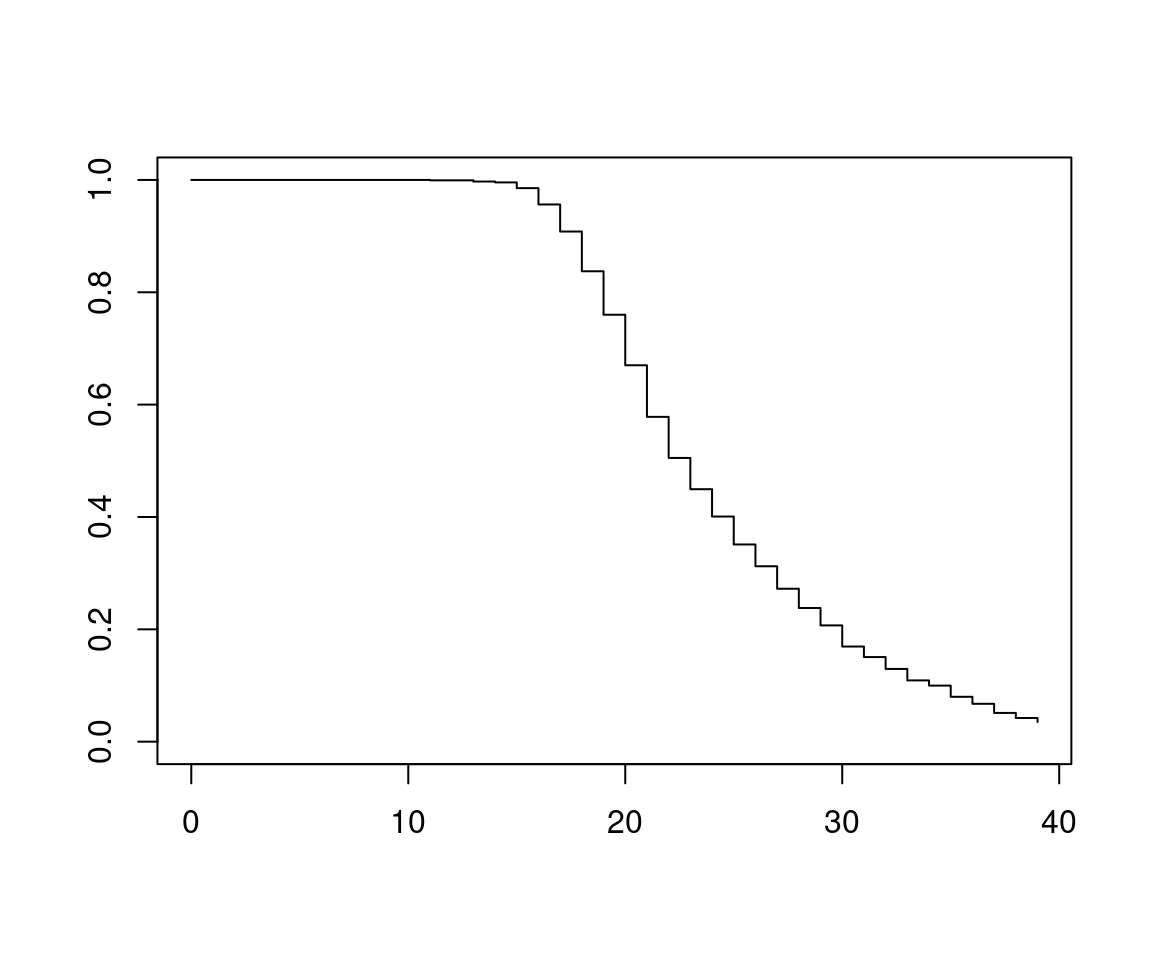
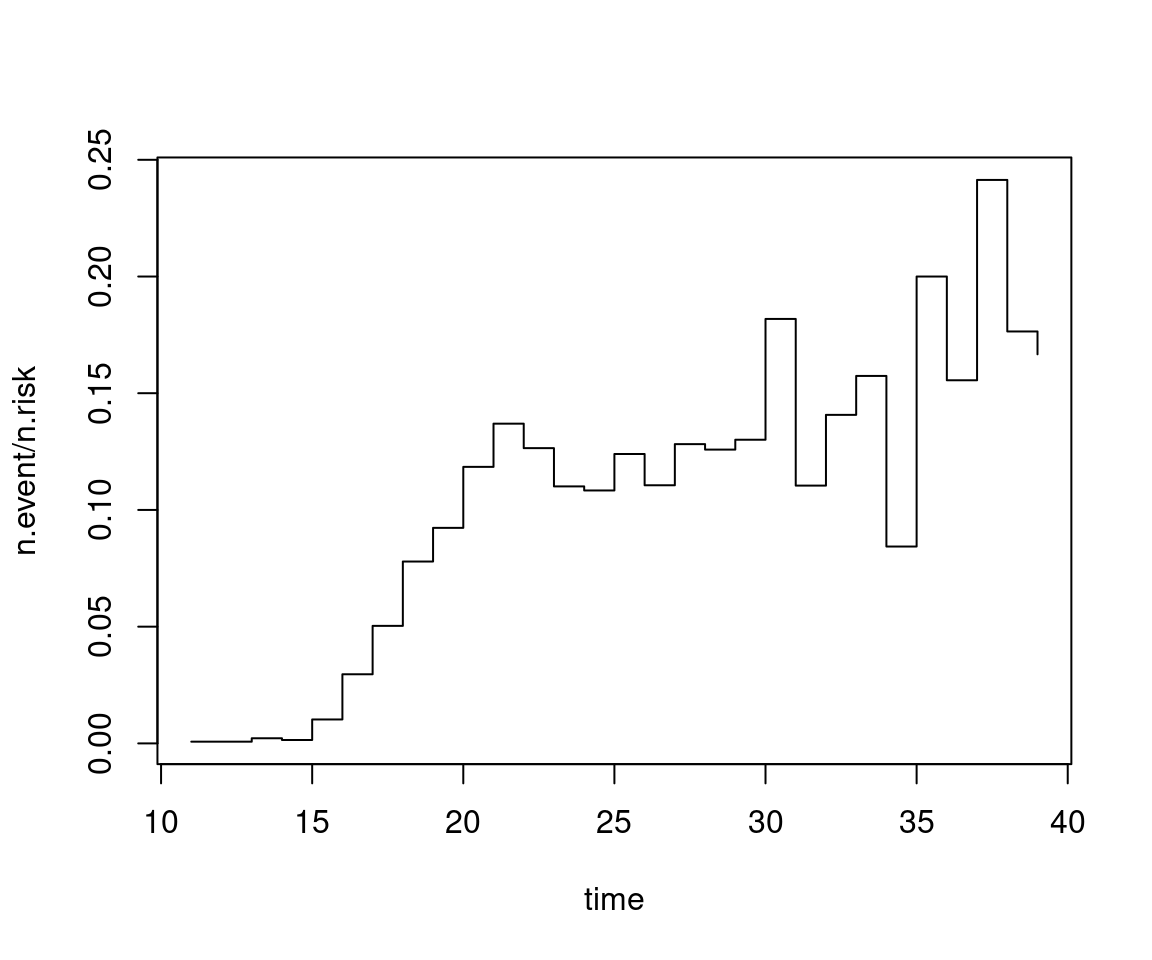
Remarks:
- \(\hat h(t) = d_s / r_s\) for \(t_{(s)} \le t < t_{(s + 1)}\) is a less reliable estimator for the hazard function. Grouping or smoothing (similar to histograms or kernel densities) would be necessary but rare in practice.
- Parametric approach: Estimate distribution parameters (and thus the associated survivor and hazard functions).
- Moreover: Regression models are required that capture how survivor and hazard functions change with covariates.
- Simple groupings can be incorporated nonparametrically in
survfit(y ~ group).
Example: For data exploration, one could consider:
gss2002$edcat <- cut(gss2002$education, c(0, 12, 14, 20))
afb_km2 <- survfit(afb ~ edcat, data = gss2002)
plot(afb_km2, col = c(1, 2, 4))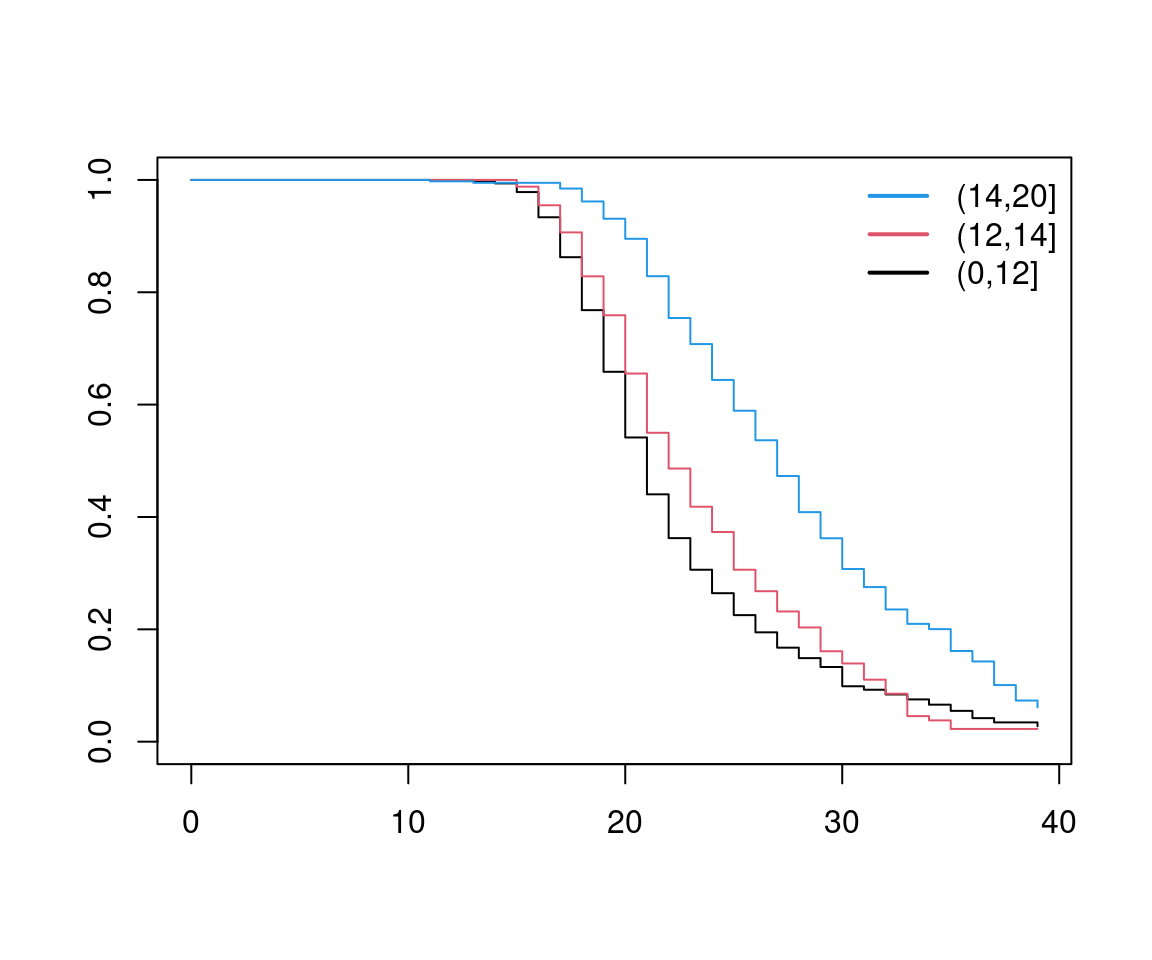
Observations: Survivor functions for different groups look very similar. This conveys that hazards are similar up to a factor. This is often exploited in modeling and inference.
Formally: The assumption of proportional hazards for two groups entails
\[\begin{eqnarray*} h_2(t) & = & c \cdot h_1(t), \qquad \mbox{(or equivalently)}\\ S_2(t) & = & S_1(t)^c. \end{eqnarray*}\]
Implication: Survivor functions cannot cross.
Remark: Violations in practice are more serious for lower death/exit times (which are based on more observations).

9.3 Continuous Time Duration Models
Basic model: Constant hazard rate \(h(t) = \lambda\) (independent of duration \(t\)) is the simplest conceivable model for duration data.
Formally: Exponential distribution with hazard rate \(\lambda > 0\).
\[\begin{eqnarray*} f(t) & = & \lambda ~ \exp (- \lambda ~ t),\\ S(t) & = & \exp (- \lambda ~ t), \\ h(t) & = & \lambda. \end{eqnarray*}\]
Remarks:
- Constant hazard rate is also called lack of memory.
- In practice nonconstant hazards (depending on \(t\)) are relevant. In economics called duration dependence.
In R: d/p/q/rexp with parameter \(\mathtt{rate} = \lambda\).
Generalization: Weibull distribution with additional shape parameter \(\alpha > 0\).
\[\begin{eqnarray*} f(t) & = & \lambda ~ \alpha ~ t^{\alpha - 1} ~ \exp (- \lambda ~ t^\alpha),\\ S(t) & = & \exp (- \lambda ~ t^\alpha), \\ h(t) & = & \lambda ~ \alpha ~ t^{\alpha - 1}. \end{eqnarray*}\]
Properties: The hazard function is always monotonic, for
- \(\alpha > 1\) increasing,
- \(\alpha = 1\) constant (exponential distribution),
- \(\alpha < 1\) decreasing.
In R: d/p/q/rweibull with parameters \(\mathtt{scale} = \lambda^{-1/\alpha}\) and \(\mathtt{shape} = \alpha\). (Further parametrizations exist in the literature.)
Example: For \(\lambda = 1\) and \(\alpha = 1/4, 1, 4\).
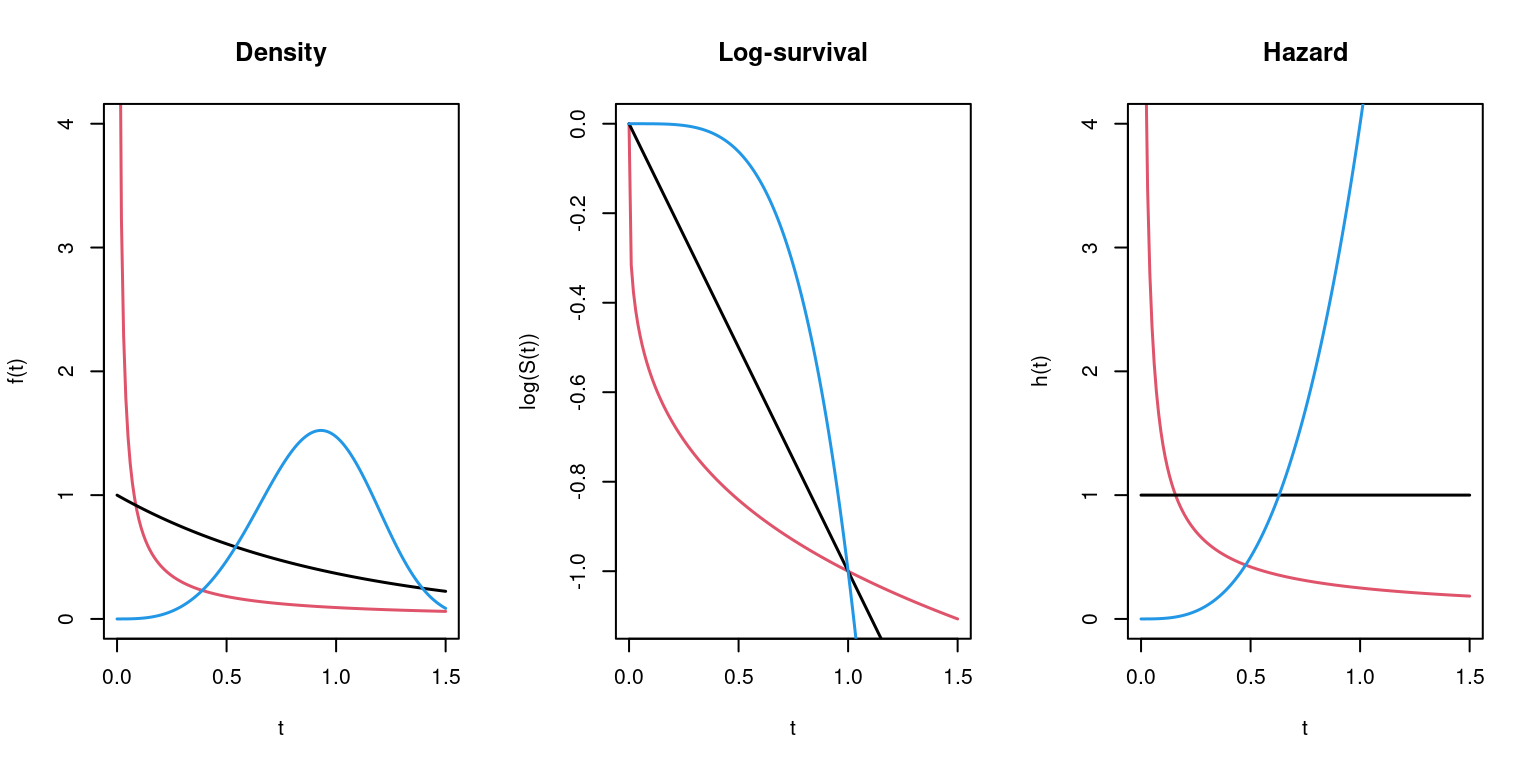
Furthermore: Distributions with potentially non-monotonic hazard functions.
- Lognormal distribution: \(\log(t) \sim \mathcal{N}(\mu, \sigma^2)\).
- Loglogistic distribution.
9.4 Proportional Hazard Models
Idea: Assume proportional hazards for observations \(i = 1, \ldots, n\).
\[\begin{equation*} h_i(t) ~=~ \lambda_i \cdot h_0(t), \end{equation*}\]
where \(h_0(t)\) is called baseline hazard.
Regression: The factor \(\lambda_i\) is allowed to depend on a set of regressors \(x_i\), typically using a linear predictor and a log link.
\[\begin{equation*} \log(\lambda_i) ~=~ x_i^\top \beta. \end{equation*}\]
Thus: Baseline hazard corresponds to observation with \(x = 0\).
Parameter estimation: Two approaches for estimation of \(\beta\).
- parametric: \(h_0(t, \alpha)\) parametric function,
- semi-parametric: leave \(h_0(t)\) unspecified.
Parametric regression models: Most common models are
- Exponential: \(h_0(t) = 1\).
- Weibull: \(h_0(t) = \alpha ~ t^{\alpha - 1}\).
Inference: Via maximum likelihood, e.g., for exponential case.
\[\begin{eqnarray*} L(\beta) & = & \prod_{i = 1}^n \left\{\lambda_i \cdot \exp(- \lambda_i t_i)\right\}^{\delta_i} \exp(- \lambda_i t_i)^{1 - \delta_i} \\ & = & \prod_{i = 1}^n \lambda_i^{\delta_i} \exp(- \lambda_i t_i) \\ \log L(\beta) & = & \sum_{i = 1}^n \delta_i \cdot x_i^\top \beta - \sum_{i = 1}^n \exp(x_i^\top \beta) \cdot t_i, \end{eqnarray*}\]
where \(\delta_i = 1\) indicates an event and \(\delta_i = 0\) censoring.
In R: survreg() from package survival.
survreg(formula, data, subset, na.action, dist, ...)
with
formula: Response must be a"Surv"object fromSurv().dist: Distribution (implying link and variance functions etc.). Available distributions include"weibull"(default),"exponential","logistic","gaussian","lognormal","loglogistic".- Similar in spirit to GLMs. However, even without censoring not always special cases of exponential families.
- Slightly different parametrization: Reports estimates for coefficients \(\tilde \beta\) and “scale” parameter \(\sigma\).
- Corresponds to \(\beta = - \tilde \beta/\sigma\) in previous notation.
- For Weibull: \(\alpha = 1/\sigma\).
Semiparametric regression: Cox proportional hazards model.
Idea: Maximum likelihood requires specification of the hazard, hence construct the conditional likelihood. Instead of \(\text{P}(T_i = t_i)\) use
\[\begin{equation*} \text{P}(T_i = t_i ~|~ \mbox{one event at } t_i). \end{equation*}\]
This leads to
\[\begin{equation*} \frac{h_0(t_i) \exp(x_i^\top \beta)}{\sum_{j: t_j \ge t_i} h_0(t_i) \exp(x_j^\top \beta)} ~=~ \frac{\exp(x_i^\top \beta)}{\sum_{j: t_j \ge t_i} \exp(x_j^\top \beta)} \end{equation*}\]
and thus, the conditional likelihood is
\[\begin{equation*} L(\beta) ~=~ \prod_{i = 1}^n \left(\frac{\exp(x_i^\top \beta)}{\sum_{j: t_j \ge t_i} \exp(x_j^\top \beta)}\right)^{\delta_i}. \end{equation*}\]
If there are censorings this is called {partial likelihood}.
In R: coxph() from survival.
Inference: For both parametric and semi-parametric models asymptotic normality can be shown. Hence, the usual inference (LR/Wald/score test, confidence intervals, information criteria) can be performed.
Interpretation: Similar to semi-logarithmic models. For observations \(x_1\) and \(x_2\)
\[\begin{equation*} \frac{h_1(t)}{h_2(t)} ~=~ \exp( (x_1 - x_2)^\top \beta), \end{equation*}\]
independent of \(t\).
Example: Determinants of AFB. Employ model formula
Of increased interest: influence of education.

afb_ex <- survreg(afb_f, data = gss2002, dist = "exponential")
afb_wb <- survreg(afb_f, data = gss2002, dist = "weibull")
modelsummary(list("AFB exponential" = afb_ex,
"AFB Weibull" = afb_wb),
fmt=3, estimate="{estimate}{stars}")| AFB exponential | AFB Weibull | |
|---|---|---|
| (Intercept) | 2.707*** | 2.890*** |
| (0.170) | (0.037) | |
| education | 0.047*** | 0.026*** |
| (0.011) | (0.002) | |
| siblings | -0.015 | -0.007** |
| (0.010) | (0.002) | |
| ethnicitycauc | 0.046 | 0.063*** |
| (0.072) | (0.016) | |
| immigrantyes | 0.094 | 0.034 |
| (0.093) | (0.021) | |
| lowincome16yes | -0.027 | 0.007 |
| (0.074) | (0.017) | |
| city16yes | 0.037 | 0.026+ |
| (0.061) | (0.014) | |
| Log(scale) | -1.487*** | |
| (0.021) | ||
| Num.Obs. | 1371 | 1371 |
| AIC | 9971.0 | 7688.7 |
| BIC | 10007.6 | 7730.5 |
| RMSE | 7.21 | 5.68 |
Comparison: Exponential and Weibull model can be compared using the standard likelihood methods.
## Likelihood ratio test
##
## Model 1: afb ~ education + siblings + ethnicity + immigrant + lowincome16 +
## city16
## Model 2: afb ~ education + siblings + ethnicity + immigrant + lowincome16 +
## city16
## #Df LogLik Df Chisq Pr(>Chisq)
## 1 7 -4979
## 2 8 -3836 1 2284 <2e-16## df AIC
## afb_ex 7 9971
## afb_wb 8 7689##
## z test of coefficients:
##
## Estimate Std. Error z value Pr(>|z|)
## education -0.1138 0.0103 -11.04 < 2e-16
## siblings 0.0296 0.0103 2.86 0.0042
## ethnicitycauc -0.2907 0.0730 -3.98 6.8e-05
## immigrantyes -0.2011 0.0928 -2.17 0.0303
## lowincome16yes 0.0304 0.0742 0.41 0.6820
## city16yes -0.0689 0.0607 -1.13 0.2564Comparison: Parameter estimates.
cf <- cbind(
"Exponential" = -coef(afb_ex),
"Weibull" = -coef(afb_wb)/afb_wb$scale,
"Cox-PH" = c(NA, coef(afb_cph))
)
cf## Exponential Weibull Cox-PH
## (Intercept) -2.70684 -12.7815 NA
## education -0.04679 -0.1133 -0.11380
## siblings 0.01549 0.0324 0.02961
## ethnicitycauc -0.04560 -0.2800 -0.29069
## immigrantyes -0.09401 -0.1517 -0.20108
## lowincome16yes 0.02725 -0.0310 0.03039
## city16yes -0.03722 -0.1139 -0.06887Hazard proportions:
## Exponential Weibull Cox-PH
## education -0.04571 -0.10715 -0.10756
## siblings 0.01561 0.03293 0.03006
## ethnicitycauc -0.04458 -0.24419 -0.25225
## immigrantyes -0.08973 -0.14072 -0.18215
## lowincome16yes 0.02762 -0.03053 0.03086
## city16yes -0.03654 -0.10765 -0.06655Compare survivor functions at \(\bar x\):
Distribution parameters:
lambda_ex <- exp(c(- xbar %*% coef(afb_ex)))
lambda_wb <- exp(c(- xbar %*% coef(afb_wb)) / afb_wb$scale)
alpha_wb <- 1/afb_wb$scaleVisualization (using Kaplan-Meier at \(\bar x\) for Cox-PH):
plot(afb_km, conf.int = FALSE)
tt <- 0:400/10
lines(tt, exp(-lambda_ex * tt), col = 3)
lines(tt, exp(-lambda_wb * tt^alpha_wb), col = 4)
lines(survfit(afb_cph), col = 2)Alternatively: Using R’s own exponential and Weibull functions requires reparametrization, i.e.
pexp(tt, rate = lambda_ex, lower.tail = FALSE)
pweibull(tt, scale = lambda_wb^(-1/alpha_wb), shape = alpha, lower.tail = FALSE)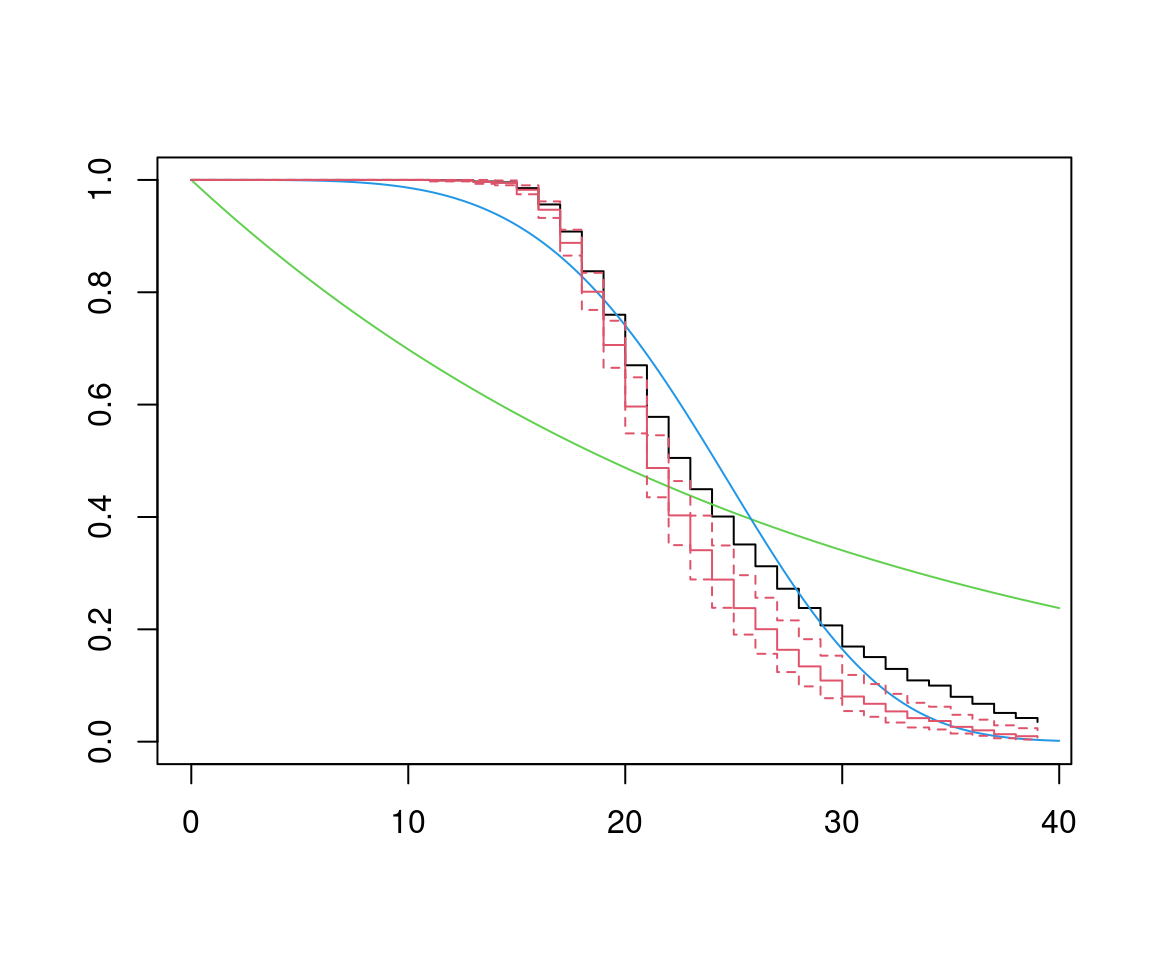 Conclusions:
Conclusions:
- Exponential is clearly inappropriate.
- Weibull and Cox-PH lead to similar results.
- Cox-PH has least restrictive assumptions.
9.5 Outlook
Alternative models: Instead of proportional hazards (PH) models, employ accelerated failure time (AFT) models.
\[\begin{equation*} \log(t_i) ~=~ x_i^\top \beta ~+~ \varepsilon_i, \end{equation*}\]
e.g., leading to lognormal model (if \(\varepsilon\) is normal) or loglogistic model (if \(\varepsilon\) is logistic).
Failure time acceleration can be seen via reparametrization
\[\begin{equation*} \log(\psi_i \cdot t_i) ~=~ \varepsilon_i, \end{equation*}\]
with \(\psi_i = \exp(- x_i^\top \beta)\) leading to shortened/lengthened survival times for \(\psi_i > 1\) and \(\psi_i < 1\), respectively.
Weibull/exponential model is the only model that is both of AFT and PH type.
Unobserved heterogeneity: Account for via additional random effects. In duration analysis called frailty models. Example: Exponential duration with gamma frailty
\[\begin{equation*} \lambda_i ~=~ \nu \cdot \exp(x_i^\top \beta), \end{equation*}\]
where \(\nu \sim \mathit{Gamma}(\theta, \theta)\) leading to Pareto type~II distribution.
Further extensions:
- Need to incorporate time-varying regressors \(x_{it}\).
- Competing risks: Deaths/exits can be caused by different types of events.
Example: Unemployment can be terminated by job or withdrawal from labor market.